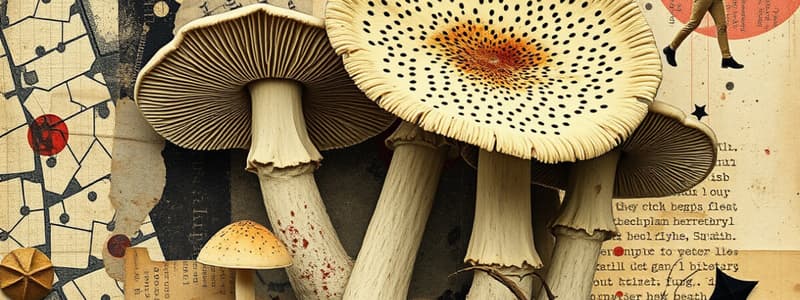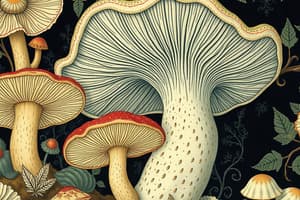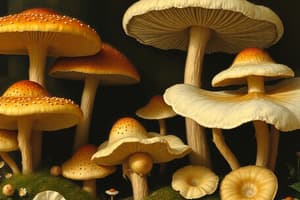Podcast
Questions and Answers
What method can be used to visualize the polysaccharide capsule of C. neoformans?
What method can be used to visualize the polysaccharide capsule of C. neoformans?
- Negative staining with India ink (correct)
- Staining with potassium hydroxide
- Culture on a formaldehyde-treated plate
- Direct examination under bright light
What is the optimum temperature range for most moulds to grow?
What is the optimum temperature range for most moulds to grow?
- 35°–40° C
- 25°–30° C (correct)
- 30°–35° C
- 20°–25° C
Which solution can be used to dissolve distracting tissue when examining specimens?
Which solution can be used to dissolve distracting tissue when examining specimens?
- 4% formaldehyde solution
- Potassium hydroxide (KOH) (correct)
- Saline solution
- Calcofluor white stain
What type of microscopy is recommended for observing specimens treated with calcofluor white stain?
What type of microscopy is recommended for observing specimens treated with calcofluor white stain?
How can culture plates be sterilized before microscopic examination?
How can culture plates be sterilized before microscopic examination?
What is the primary structural unit of molds?
What is the primary structural unit of molds?
What type of fungi reproduces asexually by budding?
What type of fungi reproduces asexually by budding?
Which term describes the mass of hyphae in fungi?
Which term describes the mass of hyphae in fungi?
What characteristic distinguishes septate hyphae from aseptate hyphae?
What characteristic distinguishes septate hyphae from aseptate hyphae?
Which of the following terms refers to a ringed structure formed during asexual reproduction?
Which of the following terms refers to a ringed structure formed during asexual reproduction?
What type of spores are produced at the tips or sides of hyphae?
What type of spores are produced at the tips or sides of hyphae?
In fungal reproduction, what process follows the joining of two compatible nuclei?
In fungal reproduction, what process follows the joining of two compatible nuclei?
Which type of fungal pigmentation is characterized as nonpigmented?
Which type of fungal pigmentation is characterized as nonpigmented?
Which systemic mycosis primarily affects middle-aged men and is also known as Gilchrist’s disease?
Which systemic mycosis primarily affects middle-aged men and is also known as Gilchrist’s disease?
What is the major characteristic of the yeast form of Histoplasma capsulatum?
What is the major characteristic of the yeast form of Histoplasma capsulatum?
Which organism's infection is transmitted through the feces of birds and bats?
Which organism's infection is transmitted through the feces of birds and bats?
Identify the organism that causes desert fever and has a distinctive barrel-shaped arthroconidia in its mold form.
Identify the organism that causes desert fever and has a distinctive barrel-shaped arthroconidia in its mold form.
What is the characteristic feature of the colony form of Paracoccidioides brasiliensis?
What is the characteristic feature of the colony form of Paracoccidioides brasiliensis?
Which compound medium is suitable for culturing Histoplasma capsulatum?
Which compound medium is suitable for culturing Histoplasma capsulatum?
Which systemic mycosis is often associated with skin lesions and lymph node involvement in the African variant?
Which systemic mycosis is often associated with skin lesions and lymph node involvement in the African variant?
What distinguishes the morphology of Blastomyces dermatitidis in culture?
What distinguishes the morphology of Blastomyces dermatitidis in culture?
Which organism is most commonly associated with Phaeohyphomycosis?
Which organism is most commonly associated with Phaeohyphomycosis?
What characteristic feature is associated with Chromoblastomycosis?
What characteristic feature is associated with Chromoblastomycosis?
Which of the following fungi can result in Mycetoma?
Which of the following fungi can result in Mycetoma?
What type of cells are found in the tissue form of Lacazia loboi?
What type of cells are found in the tissue form of Lacazia loboi?
Which fungal colony is described as flask-shaped with collarettes?
Which fungal colony is described as flask-shaped with collarettes?
Which of the following is A.k.a Madura foot?
Which of the following is A.k.a Madura foot?
Which organism produces dark colonies with jet black reverse?
Which organism produces dark colonies with jet black reverse?
What type of hyphae is associated with nonseptate tissue forms?
What type of hyphae is associated with nonseptate tissue forms?
Which stain is used to identify all fungi by staining them black?
Which stain is used to identify all fungi by staining them black?
What type of fungi includes a mold phase at room temperature and a yeast phase at 37°C?
What type of fungi includes a mold phase at room temperature and a yeast phase at 37°C?
Which of the following fungi is known to cause tinea barbae?
Which of the following fungi is known to cause tinea barbae?
What characteristic structure do Microsporum canis macroconidia have?
What characteristic structure do Microsporum canis macroconidia have?
What is the appearance of Trichophyton rubrum colonies on agar?
What is the appearance of Trichophyton rubrum colonies on agar?
Which of these fungi is characterized as having 'bamboo hyphae'?
Which of these fungi is characterized as having 'bamboo hyphae'?
What is a common symptom of tinea pedis?
What is a common symptom of tinea pedis?
Which of the following conditions is caused by Epidermophyton floccosum?
Which of the following conditions is caused by Epidermophyton floccosum?
The term 'keratinophilic' relates to fungi that have an affinity for which type of substance?
The term 'keratinophilic' relates to fungi that have an affinity for which type of substance?
What is the reverse color of colonies formed by Microsporum gypseum?
What is the reverse color of colonies formed by Microsporum gypseum?
Study Notes
General Characteristics of Fungi
- Aerobic, nucleated, and eukaryotic organisms.
- Achlorophyllous with a cell wall made of chitin (N-acetyl-D-glucosamine units).
- Maintains a neutral pH.
Mycological Terminologies
Yeast
- Unicellular, round to oval organisms (2-60 µm).
- Asexual reproduction via budding; sexual reproduction through meiosis.
Hyphae
- Long, slender branching tubes, fundamental units of molds.
- A mass of hyphae is termed mycelium; types include septate (crosswalls) and aseptate (coenocytic).
- Specialized forms include spiral, rhizoids, vegetative, and aerial hyphae.
Spores
- Act similarly to seeds in higher plants; can be sexual (karyogamy & meiosis) or asexual (mitosis).
- Asexual spores include sporangium (sac-like) and conidia (produced at hyphae tips/sides).
Reproduction of Fungi
- Asexual reproduction via conidia formation (imperfect fungi).
- Sexual reproduction (telomorph) involves joining compatible nuclei and meiosis.
Fungal Pigmentation
- Hyaline (non-pigmented) versus phaeoid (darkly pigmented).
Stains Used in Mycology
- Gomori Methylene Stain: stains all fungi black.
- Mason-Fontana Stain: stains melanin; hyaline appears pink/red and phaeoid appears brown.
Forms of Fungi
- Dimorphic fungi exhibit both mold phase (room temperature) and yeast phase (37°C + CO2); examples include Blastomyces dermatitidis and Coccidioides immitis.
- Polymorphic fungi can exist in both forms simultaneously, exemplified by Exophiala.
Systemic Dermatophyte/Cutaneous Mycoses
- Generally keratinophilic; deep infections are rare.
- Characterized by reproductive cells (microconidia & macroconidia).
Ringworm Infections (Tinea)
- Tinea capitis: scalp.
- Tinea corporis: body; "moccasin foot" refers to Tinea pedis (athlete’s foot).
Specific Dermatophytes and Their Characteristics
- Microsporum canis: Spindle-shaped macroconidia, fluffy white colony, positive fluorescence in Wood’s lamp.
- Epidermophyton floccosum: Smooth, thin-walled macroconidia, yellow-green suede appearance.
- Trichophyton rubrum: Macroconidia pencil-shaped, colonizes foot and toenails, surface white, reverse red.
Other Mycoses
Phaeohyphomycosis
- Caused by darkly pigmented fungi; displays irregular/beaded septate hyphae in tissues.
- Organisms include Dreschlera spicifera and Alternaria.
Chromoblastomycosis
- Chronic skin infection presenting with cauliflower-like surface; includes sclerotic bodies.
Mycetoma
- Characterized by chronic infections and tumor-like swellings; can be caused by fungi like Madurella.
Systemic Mycoses
- Primarily pulmonary infections that can disseminate.
Specific Systemic Mycoses
- Blastomyces dermatitidis: Gilchrist’s disease; yeast form exhibits broad-based budding.
- Histoplasma capsulatum: Transmitted via feces; microconidia are infective, leading to histoplasmosis.
- Coccidioides immitis: Infective arthroconidia; causes desert fever, with characteristic barrel-shaped spores.
Diagnostic Techniques
- Use of KOH solution can assist in visibility of fungal elements among tissue debris.
- Calcofluor white stain fluoresces upon binding to chitin in fungal walls under UV light.
Studying That Suits You
Use AI to generate personalized quizzes and flashcards to suit your learning preferences.
Description
Explore the essential features of fungi, including their cellular structure and reproduction methods. This quiz covers mycological terminologies such as yeasts, hyphae, and spores. Test your knowledge on the diversity and characteristics of these fascinating organisms.




